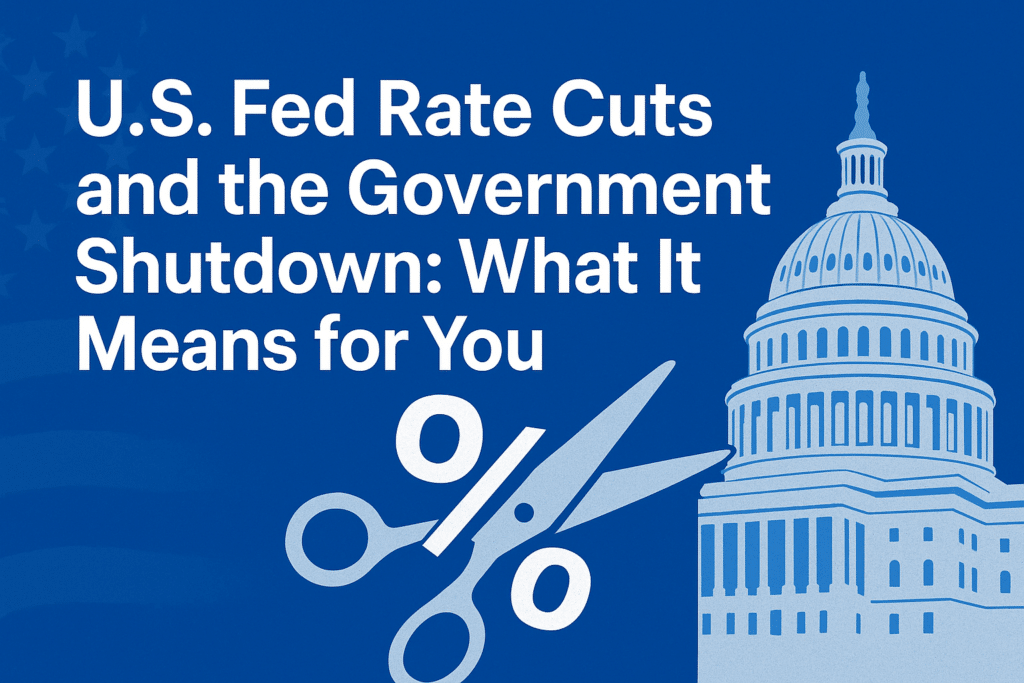
U.S. Fed Rate Cuts and the Government Shutdown: What It Means for You
Right now in the United States, two big things are happening that are connected in surprising ways: the federal government is shut down, and the Federal Reserve is cutting interest rates. We’ll break down both stories and then show how they might affect you.
Read on and scroll to the end for actions you can take.
What is happening with the government shutdown?
On October 1, 2025, the U.S. federal government began a shutdown after Congress failed to pass the spending bills needed to keep all services running.
Here are the key points:
- The shutdown is now becoming one of the longest in U.S. history.
- The budget office (Congressional Budget Office) estimates the economy could lose $7 billion to $14 billion depending on how long the shutdown lasts.
- Federal workers are being furloughed (which means laid off temporarily) or working without pay in some cases.
- Some vital services are being disrupted: for example, food aid programs and benefits may stop or slow down.
- The political standoff is deep: differences between Republicans and Democrats, especially over healthcare tax credits and spending levels, are blocking progress.
Why this matters to you
Even if you don’t work for the federal government, a shutdown can affect you:
- If you receive benefits (food stamps, federal aid, certain social services), they could be delayed or stopped.
- If you plan to borrow or invest, disruptions to data and economic signals may cause more uncertainty.
- If the economy slows, jobs and wages could become less secure.
- If the government is closed for longer, the cost to the economy gets bigger meaning bigger consequences down the road.
What you can do
- Make sure you have at least a small emergency fund in case job or income disruption happens.
- Keep a closer eye on benefit programs you rely on check whether they are still running or paused.
- If you are planning to borrow (house, car, education), consider delays or higher costs.
- Stay informed the situation could change quickly.
What is happening with the Fed rate cuts?
Around the same time as the shutdown, the Federal Reserve made a key decision. Here’s what exactly happened:
- On October 29, 2025, the Federal Reserve lowered its benchmark interest rate by 0.25 percentage points (25 basis points) to a range of 3.75% to 4.0%.
- The Fed noted that risk to employment had increased and that economic data had become weaker. Also, the shutdown means less data is coming in, making decisions harder.
- At the same time, the Fed said that a December rate cut is “not a foregone conclusion” meaning they may pause further cuts.
- Some analysts (for example, Nomura) now expect no more rate cuts in 2025 because of the mixed signals.
Why this matters to you
- When the Fed cuts rates, borrowing (for houses, cars, business) tends to become a little cheaper good for people who want loans.
- But if future cuts are uncertain, that means the cost of borrowing may not drop much further so timing matters.
- For savers, lower rates mean your savings/investments may earn less interest.
- For the economy overall, the Fed is trying to protect employment but also check inflation the balancing act is tricky especially with the shutdown messing up data.
What you can do
- If you’re thinking of financing something (house, car), check current rates and ask lenders about future changes.
- For savings, consider alternatives (but be careful with risk).
- Watch inflation: even if rates are lower, if inflation remains high your buying power may shrink.
- Stay alert: economic surprises (positive or negative) may come because the shutdown is messing with the usual flow of data.
How do these two stories connect?
These aren’t just two separate events they affect each other in important ways.
- Data gap due to shutdown: Because the government shutdown has paused or delayed many reports (jobs, production, services), the Fed has less information to make decisions. This uncertainty makes their job harder.
- Economic risk increases: The shutdown itself is dragging on the economy (billions lost). That’s a risk the Fed must account for when setting rates. A weak economy might justify cuts.
- Borrowing and spending links: If borrowing gets cheaper (via Fed cuts) but government services are disrupted (shutdown), households and businesses may behave more cautiously. That can reduce spending and slow growth.
- Policy tension: The Fed is trying to support employment and growth. But if the government is not functioning, some of the Fed’s work becomes harder and the risk of unintended consequences rises.
What could happen next?
Here are possible scenarios and what they might mean for you.
Scenario A: The shutdown ends relatively soon
- Congress passes funding bills, services resume.
- Data flows return, improving visibility for the Fed.
- The Fed may pause rate cuts or even hold rates steady.
For you: The economy stabilises, and things like loans and savings might become predictable again.
Scenario B: The shutdown drags on
- Economic losses increase (could be $11–14 billion or more).
- Business investment slows, jobs could become more at risk.
- The Fed may either cut more aggressively (to help) or be forced to hold off because of inflation concerns + data gaps.
For you: More uncertainty, possible higher risk for jobs/benefits, borrowing maybe less cheap than hoped.
Scenario C: Inflation remains stubborn or a new shock hits
- Even with cuts, if inflation doesn’t fall or new issues arise (global shocks, under employment), the Fed might reverse course and raise rates.
For you: Borrowing could become more expensive, savings might benefit but cost of living stays high.
What you should do right now
- Check your budget: With uncertainty, it’s smart to know how much you’d need if income dropped or benefits were delayed.
- Review borrowing plans: If you plan a big purchase or loan, talk to lenders about current rates and what might happen if Fed policy changes.
- Secure emergency savings: Aim for 3-6 months of living expenses if feasible.
- Watch benefit programs: If you rely on any federal programs (food stamps/SNAP, unemployment, federal jobs) track updates.
- Stay informed: Follow reliable news – this situation is fluid and decisions could shift quickly.
Final thoughts
The twin challenges of a government shutdown and the Federal Open Market Committee cutting rates show how interconnected our economy is. What happens in Washington D.C. affects your wallet, your job, your borrowing plans, and your savings.
If you act now with awareness reviewing your finances, planning for possibilities, and staying alert you’ll be better positioned to weather whatever the coming weeks bring.
If you found this useful, share it on your social media and subscribe for more updates. Also, drop a comment below: How are you preparing for what’s coming?
Let’s stay informed together.



